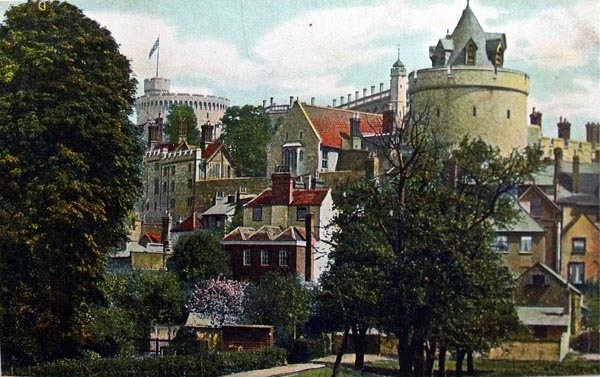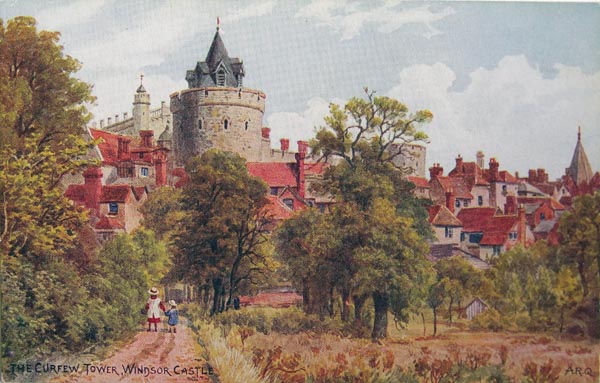
|

|
2015 |
2013 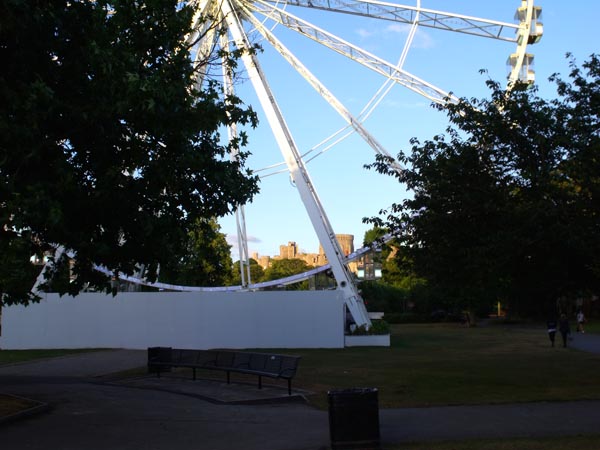
|
|
|||||||||||
The Alexandra Gardens were opened by Princess Christian, Queen Victoria's daughter, on Tuesday July 15th 1902, on a warm summer's afternoon. The Gardens were named in honour of the new Queen Consort, Queen Alexandra, Princess Christian's sister-in-law.
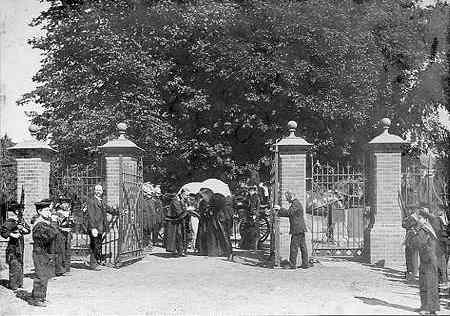
The arrival at Alexandra Gardens of Princess Christian in July 1902 for the opening of the gardens. Picture by courtesy of Peter Stickland, grandson of E A Stickland, Borough Engineer and Surveyor of Windsor from 1897 to 1930. There is an honour guard of firemen and young boys, presumably from the local sea scouts, as the Mayor Alex William Shipley welcomes Princess Christian. Behind the carriage are the mature trees of The Goswells.
An extract of the main photograph, featuring the welcoming of Princess Christian by Mayor Shipley Another extract from the main photograph, featuring a young bugler
playing a fanfare.This picture might have been taken by T E Cochrane of 27 Queen's Road, Windsor, who was often out and about photographing local events and selling his photographs as post cards. He took a lot of the 1st and 2nd Life Guards in procession between Combermere Barracks (the Cavalry Barracks) and the Garrison Church (Holy Trinity). Our thanks to Peter Stickland for sending this picture to us.
We are also grateful to Zena Middleton whose Great Aunt, Sarah Jane Ward, mentions in her diary of 1902 that she went to Alexandra Gardens that day to see Princess Christian. She writes "After dinner we had a short rest, then we went to see Alexandra Gardens opened by Princess Christian. It did not take her many minutes. The band played "God Save the King" when she arrived and when she departed. All the snobs had their photos taken. After that we went to the Round Tower and saw all the beautiful scenery all round Windsor." The complete diaries from this time are included here in the Samuel Wilkinson Diaries.
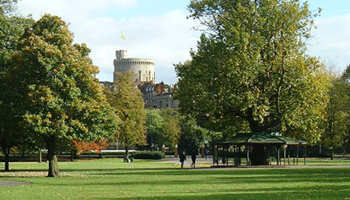
Alexandra Gardens and the view towards The Goswells with the castle beyond. Edward VII's Coronation Plane Tree is to the right of centre with covered area around its base, since removed [Jan 2005]. Plans to create a riverside garden in this area date from 1893 though the possibilities must have been discussed for some years prior to this. Two years later, in 1895, land had been purchased, and by 1902 the gardens were sufficiently complete to permit the planting of a tree in August 1902 to celebrate the Coronation of Edward VII and his Queen, Alexandra. It is a London Plane.
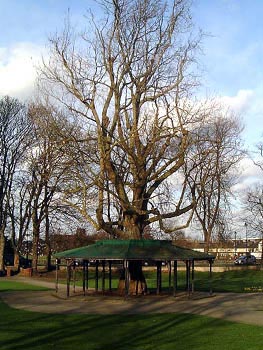
Edward VII Coronation Tree, 1902, in winter.
The original covered area with seating dates from 1954On 22 Oct 1954 a planning application was lodged with Windsor Corporation for the construction of a covered area with seating around the base of the Edward VII Coronation Tree. It was known as the George V Shelter and was built in 'booth-like' sections around the tree. The roof was originally copper sheathed but that did not last long. At some point the copper sheeting was stolen and green roofing felt was used to replace it. The seating was removed later, in the mid to late 1980s, as it was much defaced and becoming an eyesore. There was also a security implication as 'undesirables' could hide behind the seating booths, beside the tree.
The remaining covered area shown above was removed in January 2005.
Our thanks to NR who writes "With reference to your recent article regarding the Alexandra Gardens covered seating area. It brings back many fond memories of childhood picnics and football games. As a child, I distinctly remember the wooden seating being arranged in booths. As I was born in 1981, I must premise that the seating survived well into the mid-eighties rather than the seventies as was suggested in the original article. Thank you for the reminding me of great times. Great website." |
The Bandstand and Ornamental Pond
A bandstand was erected when Alexandra Gardens was first laid out and for a number of years the band of the Royal Horse Guards played there on Wednesdays from 3pm to 5pm. [Source: The Story of Windsor. Maurice Bond. Local Heritage Books.] The bandstand was located in the north-east corner of the gardens but was removed perhaps in the early 1950s though we have no information so far as to the precise date.
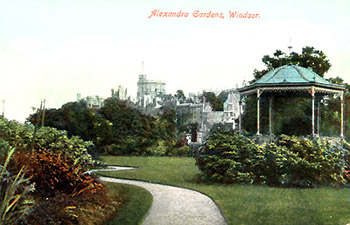
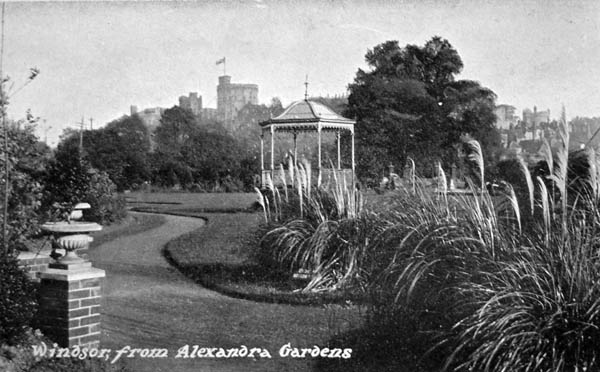
Another postcard view of the bandstand. The planting around the base is less established so this picture is probably taken at the time the gardens first opened around 1901. Note the very fresh, new-looking brickwork leading to the steps up to Barry Avenue on the left.
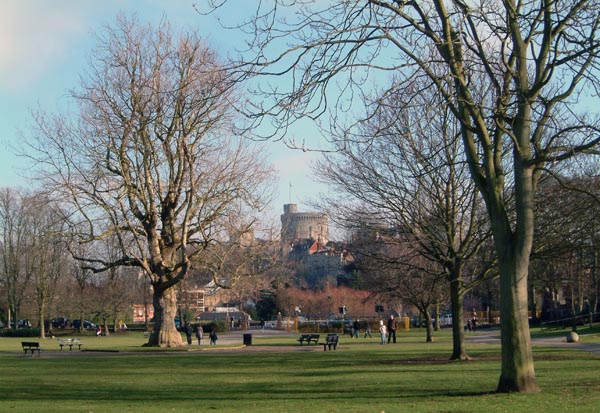
February 2010 and the tree remains but the shelter is long gone. Below is another view of the bandstand taken from the pond and sundial. These were created in 1902 by the main entrance at the east, castle end, of the gardens. The pond was drained in the early 1960s as it was leaking and for a number of years thereafter was planted up as a raised flower bed, eventually being completely removed in the 1990s.
The image below has suffered some damage but the pond, bandstand, sundial and even the horse-drawn lawn mower by the bandstand are clearly visible.
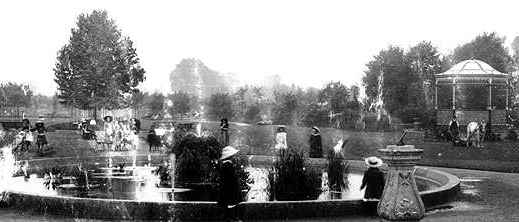
Towards the upper left is the Edward VII Coronation tree planted in 1902. Judging by the height of the tree we estimate the date of the picture to be perhaps 1910 or so.
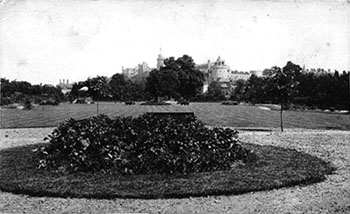
A rare early Photocrom post card of Alexandra Gardens circa 1905. (ref. 41472)
the bandstand is in the far distance, left, the Edward VII tree is centre just to the left and below the Round Tower.
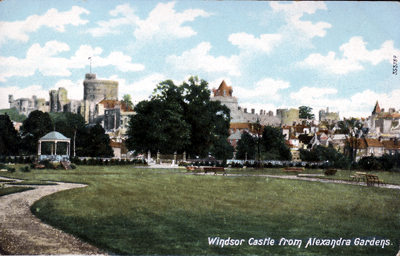
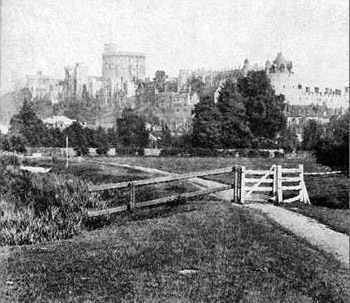
Taken from a stereoview of the area that was to become Alexandra Gardens and dating from the 1880s. The gate and pathway leads to Clewer village with Jacob's Island to the left.
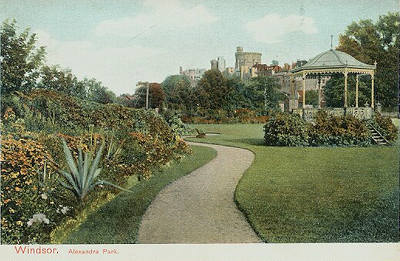
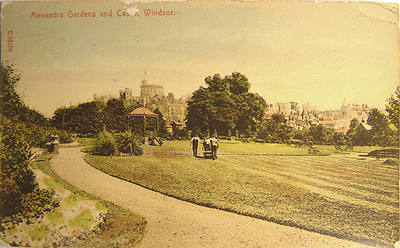
Another PC view of the bandstand. Judging by the very small plants around the base it could be very early, perhaps around 1902.
Windsor resident Phil Wells recalls "In the late 1930s, just inside Alexandra Gardens from the main gates in Goswell Road, there stood a large field gun with something like a 4" diameter barrel that we kids used to swarm over, recreating the battles of Flanders (which we always referred to as the Great War). There was also a Tank in Bachelors Acre. Both were removed early in the Second World War." Here is the only photo we have located so far of the gun Phil used to play on. It was removed at the outbreak of WWII, along with the Bachelor's Acre tank, for the scrap metal. 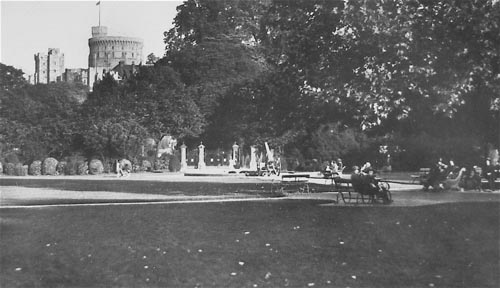 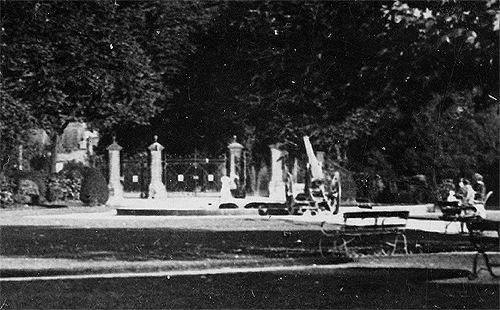 |
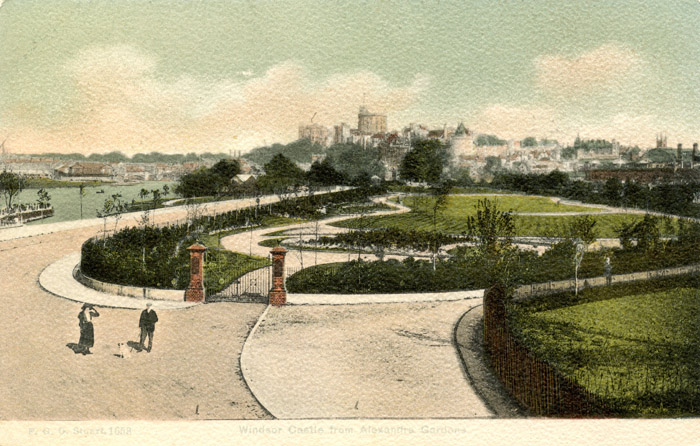
We are delighted to have found a copy of the above postcard by the famous photographer F G O Stuart. We think that it dates from around 1902, the year that the gardens had been completed. There is no sign as far as we can tell of the Coronation Tree planted at the far (Castle) end of the gardens by Edward VII in August of that year. It is possible to make out the bandstand which was a very early feature of the gardens. The photographer must have been given special permission to photograph the area from the arches of the GWR railway where the line leaves Windsor for Slough.
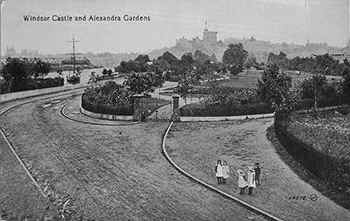
In this picture, taken a few years after the F G O Stuart view above, the gardens have obviously matured slightly and a mystery sailing ship has appeared on the river bank. Although postmarked 1925, we think that it dates from around 1904, judging by the growth that the trees have put on. The view was published by Valentine's.
In our story about the promenade and Barry Avenue, [Barry Avenue Promenade] which was constructed at around the same time, there is another view that features the large sailing vessel which was a common sight along the river front at that time.
Before the Gardens
Included below are three earlier views of the area before the gardens were created. The first two are coloured postcards and the third an early, undivided back, postcard. The address area on postcards produced before 1902 was undivided and took up a whole side, with the picture and the message sharing the reverse.
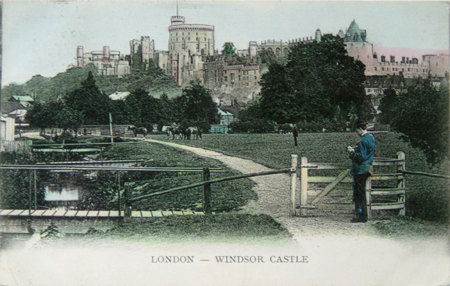
A similar view published as a tinted postcard with divided back and postmarked 1904. However, the view is believed to date from the early 1890s or even late 1880s. The card was published by Edmund Düsédau of London, Plaistow, [sic] no. 15. Judging by the tree and bush growth the views are from a very similar period to the stereoview above. However there are differences in the fencing and of course the walk ways to Jacobs Island are not evident in the stereoview. Interestingly the card is captioned 'LONDON - WINDSOR CASTLE'. Foreign visitors sometimes assume that Windsor is part of London and this may be the reason for the error in the captioning. Edmund Düsédau was known to be based in Plaistow, London in February 1904, but has not so far been found in any Internet searches as a postcard publisher [October 2006), but it is possible that he had recently come to the UK and established a postcard business.
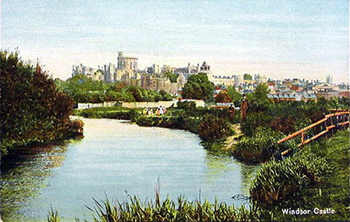
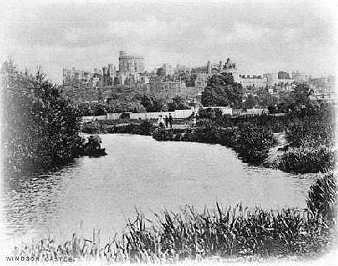
An almost identical view of the same area from an early undivided back postcard dating from the 1890s. The artist who created the colours for the tinted version has adjusted the figures standing on the bank (centre) and cropped the original to lose the fencing, but we are sure it is the from same original.
From 'The Sentinel'
December 1886
|
The Goswells - the name derives from 'goose fields' - that we know today were purchased by public subscription in 1910 in order to preserve the world-famous views of the castle from Alexandra Gardens and further west. The area features bowling and putting greens (closed in the early 2000s) to the left and hard tennis courts and a maze path to the right. Former Borough Engineer and local historian Gordon Cullingham prepared the following article in 1996.
THE GOSWELLS
History and Royal Displeasure (1909-1910)A plan of the area that the National Trust was planning to purchase in 1910
with the help of public, and royal, subscriptions.This area was acquired by the "NATIONAL TRUST FOR PLACES OF INTEREST OR NATURAL BEAUTY" by the efforts of Princess Louise, Duchess of Argyle (3rd child of King Edward VII and Queen Alexandra) who persuaded the King (Edward VII) to head the subscription list just before he died, then managed to get her brother George V to carry on.
The National Trust objective was to preserve the view of the castle. The old theatre had burned down in 1909 and Alderman Sir William Shipley proposed to rebuild with a magnificent theatre. He employed eminent architects. The plans were approved by the Council, but the Lord Chamberlain required a safety curtain for the great proscenium arch. The Council did not realise that this virtually doubled the height of the building by reason of the fly tower of unsightly brick. The National Trust complained, as did residents in letters to the Editor of the Windsor Express.
The National Trust wrote that "it is particularly distressing to find that no opportunity had been given for protest or consideration" (NT Annual Report 1910-1911) The Maitland Underhill picture of the area in the booklet, Windsor As It Was, refers. The Borough has been responsible under an agreement with the NT since 14th October 1936, but seems to have been lax in protection of the famous view, which NT points out "has been sadly marred." The view from the river, Eton and from Windsor Bridge, also from the terrace by St. George's Chapel inside the castle was involved. I recall that the late Mr. Counsell was made to agree that the theatre's air conditioning arrangements were most unsightly.
At first it was claimed that "by Royal gifts a National picture of great beauty was being saved from disfigurement" (1909-1910)
The Goswells was originally a large area, but by 1909 it had shrunk to 3.5 acres. It was part of Clewer Common Fields, part enclosed 1776. Award, Duke of Gloucester, Geo III 0.34 Clewer. Lord of the Manor: Arthur Vansittart of Shottesbrooke. Several Freeholders and Copyholders, also Churchwardens and Overseers of the Poor, £5 pa@ Xmas. (14 pages)
The Luff Library, in Windsor Library Local Studies section, has copies of relevant papers. The NT records are retained at Hughenden Manor.
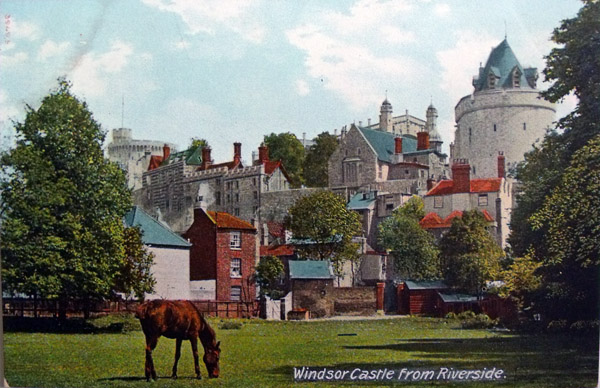
The view above is pre-1907 and is a tinted card from a black and white original, as was the technology of the day. The white building to the left, and the one adjacent with three storeys, are below Thames Street on the edge of the area bounded by River Street (Bier Street). The area was demolished in 1926 when the River Street Car Park was created. At the time this photo was taken the area would have been known as Goswell Meadows. It is believed that the previous owners were Christ's Hospital in London.
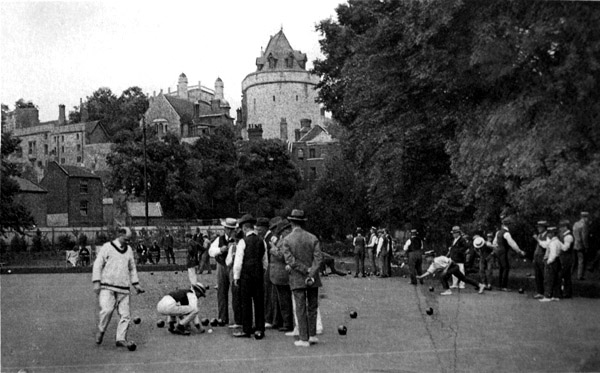
This almost identical view was taken between 1922, when the Bowling Club was founded, and 1926, when the buildings on the extreme left were demolished.
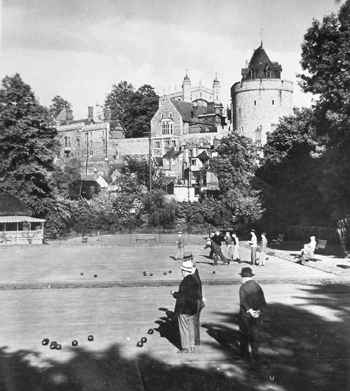
The Bowling Club came into existence following a meeting in The Guildhall in November 1921 with the green, pavilion, and its famous thatched roof, being created in 1922. Although the thatching was replaced from time to time, the final thatching was in 1990 for by 2006 costs had escalated to such an extent that it was decided that a slate roof should replace the thatch. There is more history about the Bowling Club here.
Boots Passage celebrates the earlier Boots shop premises that were closed in 1917 and the shops redeveloped. The passage and steps were donated to the borough by Jesse Boot and, at the top, are known as King Edward VII Gateway. Currently a 'King and Castle' Bar and Restaurant is part of the redevelopment.
